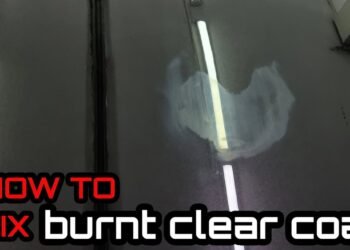When it comes to keeping your vehicle’s suspension parts in top shape, painting them isn’t just about looks—it’s about protection. You want your suspension to resist rust, dirt, and wear so it performs well and lasts longer.
But how do you choose the right paint? What steps ensure the paint sticks and stays durable under tough conditions? If you’ve been wondering how to paint suspension parts like a pro, you’re in the right place. This guide will walk you through simple, effective tips to get a smooth, long-lasting finish that protects your suspension and keeps your ride looking sharp.
Ready to transform your suspension parts and extend their life? Let’s dive in!

Credit: www.bmw2002faq.com
Choosing Paint For Suspension
Picking the right paint for suspension parts is key for durability and look. Suspension parts face dirt, water, and heavy wear. Paint must protect against rust and damage. It should also stick well to metal and handle shocks.
Different paints offer various benefits and finishes. Knowing their features helps you make the best choice. Below are common paint types used for suspension parts.
Direct-to-metal Paints
Direct-to-metal (DTM) paints work well on bare metal. They often contain rust inhibitors to stop corrosion. These paints stick tightly without a primer, saving time. DTM paints dry fast and resist chipping. They provide solid protection for suspension parts exposed to elements.
Acrylic Options
Acrylic paints are water-based and easy to apply. They dry quickly and offer good flexibility. This flexibility helps prevent cracking on moving parts. Acrylic paints resist water and UV rays, keeping colors bright. They clean up easily with water, making them user-friendly.
Oil-based Paints
Oil-based paints create a tough, hard finish. They take longer to dry but offer strong protection. These paints resist chemicals and wear well. Oil-based options work well on suspension parts exposed to oil and grease. Surface prep is important for good adhesion with oil paints.
Epoxies And Powder Coatings
Epoxy paints form thick, durable coats on metal. They resist moisture, chemicals, and impact. Powder coating is a dry finishing process that creates a hard shell. Both provide excellent protection for heavy-use suspension parts. They need special equipment but last much longer than regular paint.

Credit: www.bmw2002faq.com
Surface Preparation
Proper surface preparation is key for painting suspension parts. It ensures paint sticks well and lasts longer. Without good prep, paint may peel or chip quickly. Clean, sand, and prime the parts carefully to get the best results.
Each step helps protect the metal and gives a smooth base. Follow these simple steps for a strong, durable finish on your suspension parts.
Cleaning The Parts
Start by removing dirt, grease, and rust from the parts. Use a degreaser or soap with water for cleaning. Rinse thoroughly and let parts dry completely. A clean surface helps paint stick better and prevents imperfections.
Use a wire brush for tough rust spots. Wipe the surface with a clean cloth to remove dust. Clean parts ensure long-lasting paint and a smooth finish.
Sanding Techniques
Sanding creates a rough surface for the paint to grip. Use medium-grit sandpaper (around 120-220 grit) for metal parts. Sand evenly to remove old paint and smooth rough spots.
After sanding, wipe away dust with a damp cloth. Avoid over-sanding, which can damage the metal. Proper sanding improves paint adhesion and prevents peeling.
Applying Primer
Apply a metal primer to protect the parts from rust. Choose a primer made for metal and compatible with your paint. Spray or brush on a thin, even coat.
Let the primer dry fully before painting. Primer creates a strong bond and improves the paint’s durability. It also helps paint colors look brighter and more even.
Painting Techniques
Painting suspension parts requires careful technique to ensure durability and a smooth finish. The right method protects metal from rust and wear. It also improves the look of your vehicle’s undercarriage.
Different painting techniques suit different parts and tools. Choosing the correct approach helps the paint last longer and resist chipping. Proper surface preparation is key before starting any painting process.
Spray Painting Tips
Use spray paint for an even coat on complex shapes. Hold the spray can 6 to 12 inches away from the surface. Move the can steadily side to side for uniform coverage. Apply several thin layers instead of one thick coat. Let each layer dry before applying the next. Use paint made for metal and high temperatures. Spray painting reduces brush marks and reaches tight spots.
Brush And Roller Methods
Brushes and rollers work well on flat or simple surfaces. Choose a high-quality brush with synthetic bristles for smooth strokes. Use a small roller for larger flat areas. Apply paint evenly to avoid drips and streaks. Clean brushes and rollers immediately after use. These tools allow more control but take longer than spray painting.
Layering And Drying Times
Apply paint in thin, even layers for best results. Thin layers dry faster and stick better. Wait 15 to 30 minutes between layers, depending on paint type. Follow the manufacturer’s drying time instructions. Rushing can cause bubbles or peeling. Proper drying ensures a tough, long-lasting finish on suspension parts.
Ensuring Durability
Durability is key when painting suspension parts. These parts face harsh conditions daily. They encounter moisture, heat, and chemicals. A durable paint job keeps parts looking good and working well. It also helps avoid costly repairs and replacements.
Using the right methods ensures the paint lasts longer. It protects the metal underneath. Let’s explore essential techniques to keep suspension parts strong and lasting.
Rust Protection Methods
Rust can ruin suspension parts quickly. Protecting metal from rust extends its life. Start by cleaning all dirt and grease from parts. Next, use a rust-inhibiting primer. These primers block moisture from reaching metal. Applying paint designed for metal adds another barrier. Powder coating is also an option for strong rust defense. Regular checks for chips or scratches help catch rust early.
Heat Resistance
Suspension parts often get hot during use. Paint must resist high temperatures without peeling. Use heat-resistant paints made for engines and metal parts. These paints keep color and finish even under heat. Avoid regular spray paints that can soften or discolor. Proper curing of paint improves heat resistance. This ensures parts look good after long use.
Chemical And Abrasion Resistance
Suspension parts face chemicals from roads and maintenance. Salt, oil, and brake fluid can damage paint. Use chemical-resistant paints to protect these parts. Abrasion from dirt and stones also wears paint away. Tough coatings prevent scratches and chips. A strong finish keeps the suspension parts safe and clean. Reapply paint or protective layers as needed for ongoing protection.
Common Mistakes To Avoid
Painting suspension parts requires care and attention. Avoiding common mistakes ensures a long-lasting and smooth finish. Many beginners rush the process, leading to peeling or rust. Understanding these errors helps protect your investment and improve the look of your vehicle.
Skipping Surface Prep
Surface preparation is vital before painting suspension parts. Dirt, grease, and rust prevent paint from sticking properly. Clean the parts thoroughly using a degreaser. Sand the surface to remove old paint and rust spots. Skipping this step causes uneven paint and early chipping.
Using Incompatible Paints
Not all paints work well on metal suspension parts. Choose paints designed for metal and high heat. Using regular paint may cause peeling or fading. Direct-to-metal (DTM) paints or specialized primers offer better adhesion and rust protection. Check product labels before purchasing paint.
Insufficient Drying Time
Drying time between coats is crucial for a durable finish. Rushing the process traps moisture and weakens the paint layer. Follow manufacturer instructions for drying times. Apply thin coats and wait fully before adding more. This prevents runs, bubbles, and peeling later.

Credit: www.youtube.com
Maintenance After Painting
Maintaining painted suspension parts ensures their durability and appearance. Proper care protects the paint from damage caused by dirt, moisture, and road debris. Regular maintenance keeps the parts looking fresh and extends their lifespan. Follow simple steps to clean, touch up, and care for your painted suspension components effectively.
Cleaning Painted Parts
Use a soft cloth or sponge to clean painted suspension parts gently. Avoid harsh chemicals that can damage the paint. Mild soap and water work best to remove dirt and grime. Rinse thoroughly to prevent soap residue. Dry the parts with a clean towel to avoid water spots. Clean regularly to keep the paint smooth and bright.
Touch-up Tips
Inspect painted parts for chips or scratches often. Small damages can lead to rust if left untreated. Use matching paint to touch up affected areas. Apply paint carefully in thin layers for a smooth finish. Allow each layer to dry before adding another. Touch-ups help maintain the protective layer and appearance.
Long-term Care
Protect painted suspension parts from extreme weather and chemicals. Store vehicles in a garage or covered area when possible. Avoid driving through mud or salt that can harm the paint. Apply a clear coat or sealant for extra protection. Check parts regularly and address any issues quickly. Long-term care preserves both function and look.
Alternative Coating Options
Choosing the right coating for paint suspension parts extends the life of your vehicle components. Alternative coating options offer strong protection and enhance appearance. These coatings resist rust, chips, and wear better than traditional paint. They also reduce maintenance needs and keep parts looking newer longer.
Powder Coating Benefits
Powder coating uses a dry powder applied electrostatically to metal parts. It then cures under heat, forming a tough, smooth finish. This coating is thicker and more durable than regular paint.
It resists scratches, corrosion, and fading well. Powder coating also provides a uniform finish without drips or runs. It is environmentally friendly with no solvents or harmful fumes. This option is ideal for suspension parts exposed to harsh conditions.
Underbody Protection Products
Underbody protection products shield the vehicle’s underside from road debris and moisture. These coatings create a flexible barrier that absorbs impacts and prevents rust. They often contain rubberized or wax-based compounds for added durability.
Applying underbody protection helps prevent corrosion in suspension and chassis parts. It reduces noise and vibration while driving. These products are easy to apply and can be touched up as needed.
Frequently Asked Questions
Can You Paint Suspension Arms?
Yes, you can paint suspension arms. Clean, sand, and apply a metal primer first. Use durable paint like epoxy or oil-based for lasting protection.
What Paint To Use On Gun Parts?
Use high-temperature resistant spray paints like Rust-Oleum or Dupli-Color Engine Enamel on gun parts. Clean, sand, and prime metal surfaces first. Choose paints designed for metal to ensure durability and rust protection. Avoid peeling by proper surface preparation and using quality primers before painting.
What Kind Of Paint Will Stick To Metal?
Direct-to-metal (DTM) paints, acrylic, and oil-based paints stick well to metal. Proper cleaning, sanding, and priming ensure better adhesion and durability.
Can You Paint Your Shock Absorbers?
Yes, you can paint shock absorbers. Clean, sand, and prime them first for better paint adhesion and durability. Use high-temperature, rust-resistant paint designed for metal. Proper preparation ensures a long-lasting, protective finish. Avoid painting moving parts to maintain shock absorber performance and safety.
What Type Of Paint Is Best For Suspension Parts?
Durable enamel or direct-to-metal (DTM) paints work best for suspension parts. They resist rust and stick well.
Conclusion
Painting suspension parts adds protection and improves their look. Use proper cleaning and priming for best results. Choose paint made for metal and rust resistance. Apply thin, even coats and let each dry fully. Regular maintenance helps keep the paint strong and lasting.
A well-painted suspension lasts longer and stays rust-free. Simple steps make a big difference in your vehicle’s durability. Keep your suspension parts safe with the right paint and care.

















